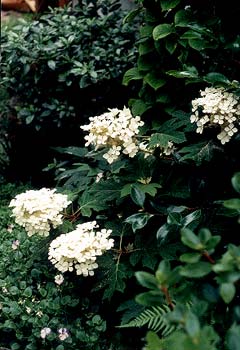
Oakleaf Hydrangia,
a shade-garden's treasure
"Dragoons, I tell you the white hydrangeas turn rust & go soon.
Already mid September a line of brown runs over them.
One sunset after another tracks the faces, the petals.
Waiting, they look over the fence for what way they go."
-Carl Sandburg
(1878-1967
(1878-1967
Oakleaf Hydrangea is native of the American south, ranging from Tennessee to Florida & west to the Mississippi River. But it seems to be just as much an ideal shrub for temperate regions, such as here in the Northwest, for it does not miss the warm southern climate.
John Bartram introduced this plant to gardening in 1791 (you can read a bit about Bartram, "The Father of American Botany," on the a Beebalm Page). Being so long in cultivation, several Oakleaf Hydrangea cultivars have been developed.
It is almost entirely disease free, & the only complaint I have ever heard about it is it can be slow to establish & take a few years to start blooming, a problem mitigated by starting with a two or three foot tall plant that already has a substantial root.
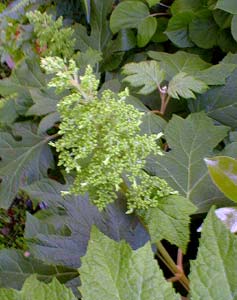 We placed our Oakleaf Hydrangea on the sunnier side of our shade corridor. It is only four feet feet tall & wide (as of 2003). It could easily grow five to eight feet tall & wide, but the corridor is rather narrow & we are forced to occasionally cut it back from the path so that it remains narrower.
We placed our Oakleaf Hydrangea on the sunnier side of our shade corridor. It is only four feet feet tall & wide (as of 2003). It could easily grow five to eight feet tall & wide, but the corridor is rather narrow & we are forced to occasionally cut it back from the path so that it remains narrower.Until the root system is extremely well established, Oakleaf Hydrangeas are slow-growing, so we have not up to now had to prune it a great deal, as only the occasional limb has intruded too far into the path. In the long run, however, we may find it needs to be hard-pruned every two or three years, which will preserve it as a compact shrub.
The Climbing Hydrangea behind the Oakleaf is climbing its way to the top of the wall. We're allowing the climber to develop as a big bushy "wall shrub" overhead, while limiting its spread at the base, where room is preserved for the Oakleaf.
When it does become necessary to prune an Oakleaf Hydrangea, this is best done late Summer or in Autumn, at any time after it is done blooming. Pruning is not demanded to keep the shrub pleasant; if there's room, it can be left unpruned indefinitely, so trims are merely to limit its size or for aesthetic shaping.
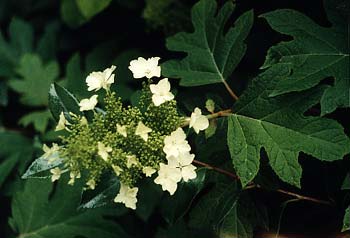 Early fall pruning causes the flowers to be more numerous & smaller the next year, whereas spring pruning risks loss of buds. Spring pruning is even so not unreasonable; it will result in fewer but larger blossoms. No pruning at all also induces more but smaller blooms.
Early fall pruning causes the flowers to be more numerous & smaller the next year, whereas spring pruning risks loss of buds. Spring pruning is even so not unreasonable; it will result in fewer but larger blossoms. No pruning at all also induces more but smaller blooms.Several varieties including a dwarf called "PeeWee" do not exceed three or four feet high & wide at the outside, & as ours was obtained unlabeled, we have thought it might be a dwarf. Probably it's not a dwarf, but has thus far remained small because hydrangeas really can take up to four years to establish excellent roots, after which they can begin to put on height & width with greater abandon.
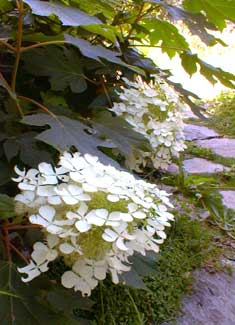 Besides being slow to establish, ours was stressed because its first year was spent in way too shady a location. Other, swifter-growing shrubs outgrew it & it was nearly impossible to see where it was at, so I moved it the second year to the location its been in ever since. When I dug it up, I was somewhat alarmed to discover it had established no new roots at all, but was still a container-shaped root-clump. My suspicion is that has been only temporarily stunted from the abject lack of light it experienced that first year in its previous location, & from having been rootbound in the nursery's container. In 2002 & 2003 since moving it, it has been far more lively.
Besides being slow to establish, ours was stressed because its first year was spent in way too shady a location. Other, swifter-growing shrubs outgrew it & it was nearly impossible to see where it was at, so I moved it the second year to the location its been in ever since. When I dug it up, I was somewhat alarmed to discover it had established no new roots at all, but was still a container-shaped root-clump. My suspicion is that has been only temporarily stunted from the abject lack of light it experienced that first year in its previous location, & from having been rootbound in the nursery's container. In 2002 & 2003 since moving it, it has been far more lively.The leaves are large — eight inches on average — & can be still bigger with shade-grown specimens. A leaf portrait is shown last on this page (September 2003) Though nominally deciduous, our Oakleaf Hydrangea keeps its leaves until January or March or even later, never losing its greenness.
Ours keeps all its leaves until new young leaves are barely beginning, & even then, the old leaves may have to be physically removed or they will keep new spring growth excessively shaded. The old leaves can be tested now & then with a tug, to see if they are willing to let go, but eventually they really must be gotten off to make room for budding new growth.
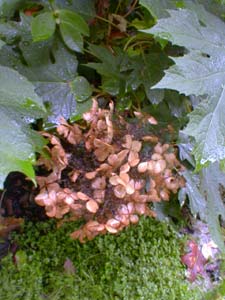 Although ours has proven to be strongly evergreen through our mild winters, this cannot be expected of all specimens, as the behavior of Oakleaf Hydrangea varies greatly from plant to plant, from strain to strain, & depending on garden conditions or zone.
Although ours has proven to be strongly evergreen through our mild winters, this cannot be expected of all specimens, as the behavior of Oakleaf Hydrangea varies greatly from plant to plant, from strain to strain, & depending on garden conditions or zone.The ideal specimens would not be even semi-evergreen, but should be dramatically deciduous, with gorgeous autumn leaves of mahogony & burgundy; but this too varies a lot. They sometimes stay quite green well into autumn, & the more colorful fall colors tend to be on specimens planted in more sunlight than the shrub generally prefers. In exchange for ours being almost fully evergreen, we don't get the famed autumn colors, though the leaves on ours do become nicely bronzed in winter.
Unlike regular bigleaf hydrangea with large balled flowers, the color of the flowers cannot be regulated by changing soil pH. I underscore that fact because I persistently hear of people attempting this effect with Oakleaf, but it is a waste of effort, & might unduly stress the plant by with shifting pH.
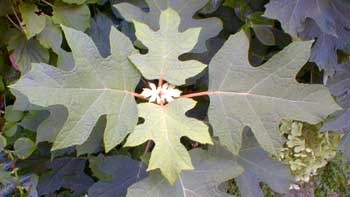 The Oakleaf has large conical clusters of flowers. These are by early June a cone of green buds , opening into impressive blossoms by late June & lasting very strongly on through to August. It blooms on old wood from buds that were set the year before.
The Oakleaf has large conical clusters of flowers. These are by early June a cone of green buds , opening into impressive blossoms by late June & lasting very strongly on through to August. It blooms on old wood from buds that were set the year before.The white flowers fade to pink, then dry out on the limbs about September, when they become a rich tan still holding their shape. These dried flowers can be left on the shrub until they are no longer attractive, which could easily be until mid winter, or they can be cut off & kept as dry flowers for indoor arrangements. The fifth photo on this page is of the dried flowers (October 2003).
It blooms very easily & while some have reported it took a few years before theirs bloomed, we have not had that experience. Even its first year when it was stressed in too dark a location, it bloomed handsomely.
Like the Climbing Hydrangea, it has hairy red twigs & exfoliating cinnamon-colored bark on the older branches, so if one has a specimen that behaves more properly as a deciduous shrub, it will still be quite interesting even when leafless in winter. The twigs can be poisonous to livestock, though deer sometimes eat them safely. I've never heard of pets or kids being harmed by the extremely mild toxins.